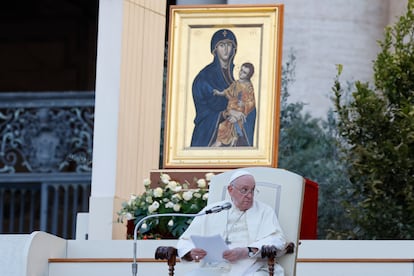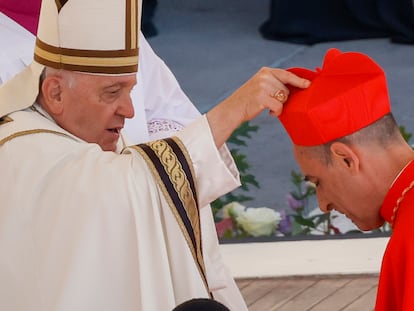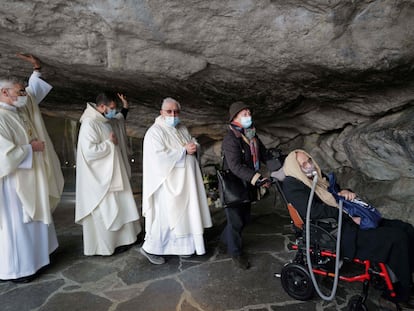Things to know about the Vatican’s big meeting on the future of the Catholic Church
For the first time, women and laypeople can vote on specific proposals alongside bishops, a radical change that is evidence of Francis’ belief that the church is more about its flock than its shepherds.

Pope Francis on Wednesday is opening a global gathering of bishops and laypeople to discuss the future of the Catholic Church, including some hot-button issues that have previously been considered off-limits for discussion.
For the first time, women and laypeople can vote on specific proposals alongside bishops, a radical change that is evidence of Francis’ belief that the church is more about its flock than its shepherds.
Here is some background on the Oct. 4-29 Synod of Bishops, which will be followed by a second session this time next year. That session is expected to put forward specific proposals for Francis to consider in a future document.
What’s on the agenda?
The working document for the meeting was compiled by a committee after an unprecedented two-year canvassing of rank-and-file Catholics around the globe.
The final product is meant to stimulate debate and poses agenda items in the form of questions. But some of the questions also make clear a certain consensus was reached during the consultation phase.
For example, the document calls for concrete steps to promote women to decision-making roles in the church, including as deacons, and for ordinary faithful to have more of a say in church governance.
It calls for a " radical inclusion” of LGBTQ+ Catholics and others who have been marginalized by the church, and for new accountability measures to check how bishops exercise their authority to prevent abuses.
“From all corners of the world, greater inclusion and support for LGBTQ+ people have emerged as a top pastoral issue for the Catholic Church,” said New Ways Ministry, which advocates for LGBTQ+ Catholics.
What’s the controversy?
Some conservatives have expressed doubts about the synod ever since Francis announced it three years ago. They have warned that bringing up for debate issues that have already been settled by the church risks schism.
They have penned articles, written books and hosted conferences. Just this week, five conservative cardinals from Europe, Asia, Africa and the Americas made their challenge to Pope Francis public.
In a letter posed as five questions, or “dubia,” they asked him to affirm church teaching on matters of doctrine, homosexuality, female ordination and church authority because they said the synod was sowing confusion.
Francis responded to the cardinals in a letter released by the Vatican on Monday. He explained that changes in the world stimulate the church to better understand and explain its teachings, and that the synod is a way to discern the path forward.
“With much sincerity, I tell you it’s not good to be afraid of these questions,” Francis told them.
Who’s coming?
There are 365 voting members including the pope, 54 of whom are women. Their numbers are divided among delegates chosen by national bishops’ conferences, members nominated by the pope himself and 10 priests and nuns chosen by religious orders.
In addition, there are around 100 experts and “facilitators” who have been brought in to help move the dialogue along as the meeting works through the agenda. But they won’t vote on any final document.
Two late additions to the list are bishops from China, in an important signal of cooperation as the Vatican and Beijing try to improve ties particularly over the life of the Catholic Church in China.
Bishops Antonio Yao Shun from Jining in Inner Mongolia and Yang Yongqiang from Zhoucun of Shandong Province were nominated by Francis after the church in China put their names forward.
The archbishop of Hong Kong, Cardinal Stephen Chow, said their participation was particularly significant.
“It’s a sign of goodwill and possibly that they realize the church in China and the government wants to say there should be closer, more episcopal contacts between China and the universal church,” Chow told The Associated Press. “Their presence is really speaking to that.”
A secret synod?
The two-year preparatory phase of the synod was marked by a radical transparency in keeping with the goals of the process for participants to listen to each other and learn from one another. So it has come as something of a surprise that Francis has essentially imposed a media blackout on the synod itself.
While originally livestreams were planned, and several extra communications officers were hired, organizers have made clear this is a closed-door meeting and participants have been told to not speak to journalists.
Paolo Ruffini, in charge of communications for the meeting, denied the debate had been put under the pontifical secret, one of the highest forms of confidentiality in the church.
He insisted that it was a liturgical moment of prayer and discernment, pointing to a 1990 essay by a late cardinal extolling the benefits of “silence” in communication.
No daily briefings are planned as in previous synods, though five are scheduled over the course of the meeting. Francis has defended the new regime as favoring real dialogue.
Challenged on the lack of transparency, Francis has said he didn’t want “political gossip” leaking out with news of participants duking it out over tough issues.
“This isn’t a television show,” he told reporters during an airborne news conference in August.
Sign up for our weekly newsletter to get more English-language news coverage from EL PAÍS USA Edition
Tu suscripción se está usando en otro dispositivo
¿Quieres añadir otro usuario a tu suscripción?
Si continúas leyendo en este dispositivo, no se podrá leer en el otro.
FlechaTu suscripción se está usando en otro dispositivo y solo puedes acceder a EL PAÍS desde un dispositivo a la vez.
Si quieres compartir tu cuenta, cambia tu suscripción a la modalidad Premium, así podrás añadir otro usuario. Cada uno accederá con su propia cuenta de email, lo que os permitirá personalizar vuestra experiencia en EL PAÍS.
¿Tienes una suscripción de empresa? Accede aquí para contratar más cuentas.
En el caso de no saber quién está usando tu cuenta, te recomendamos cambiar tu contraseña aquí.
Si decides continuar compartiendo tu cuenta, este mensaje se mostrará en tu dispositivo y en el de la otra persona que está usando tu cuenta de forma indefinida, afectando a tu experiencia de lectura. Puedes consultar aquí los términos y condiciones de la suscripción digital.
More information
Últimas noticias
Most viewed
- Sinaloa Cartel war is taking its toll on Los Chapitos
- Oona Chaplin: ‘I told James Cameron that I was living in a treehouse and starting a permaculture project with a friend’
- Reinhard Genzel, Nobel laureate in physics: ‘One-minute videos will never give you the truth’
- Why the price of coffee has skyrocketed: from Brazilian plantations to specialty coffee houses
- Silver prices are going crazy: This is what’s fueling the rally










































